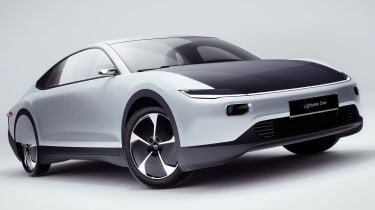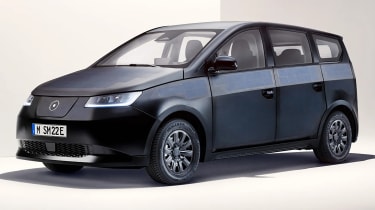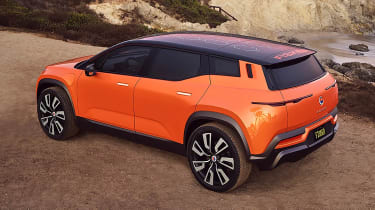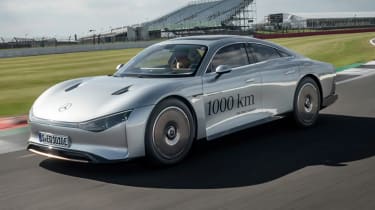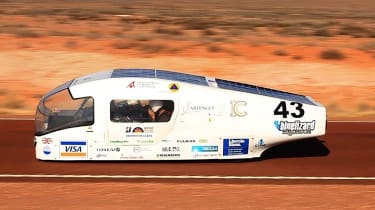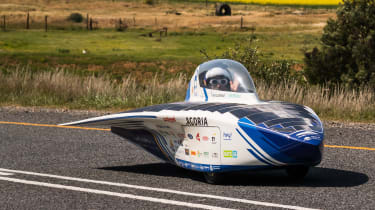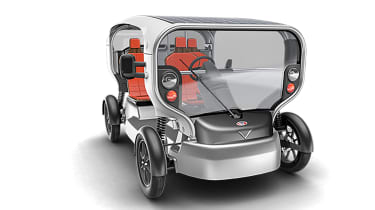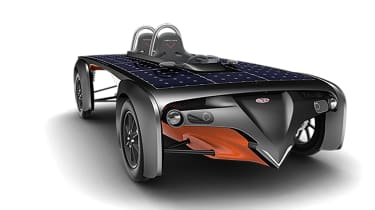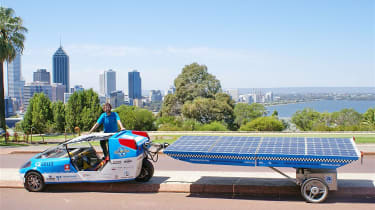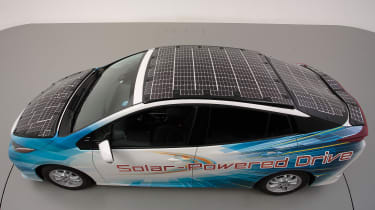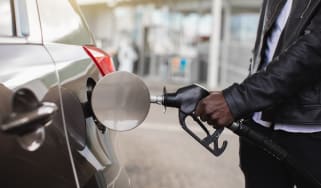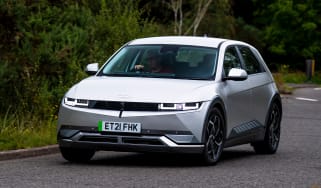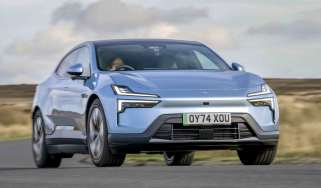Solar powered cars: amazing vehicles that run on the sun
Using clean, free power from the sun to run our cars sounds like a revolutionary answer to a lot of our current problems, but will it ever really work?
The average car in the UK is parked for 96 per cent of the time. Now imagine if, during that time, our cars were magically sucking the energy they need right out of the sky - no cost, no emissions, no more plugging in or filling up. That is the dream of the solar-powered car.
The concept of solar-powered cars is certainly a seductive one. But as you might have guessed, the reality isn’t quite on that level yet. The efficiency and cost of today’s solar panels, the amount of space available on the average car to mount them and the temperamental British weather are just some of the barriers blocking widespread adoption of the technology here.
Those barriers are coming down, however, with various prototype and production vehicles from around the world demonstrating how much is possible when it comes to cars that run on the sun.
The problem with solar-powered cars
The potential benefits of solar-powered cars are clear. The sun is an abundant source of clean, free energy. All we have to do is capture it and use it to get about the place. If only it were so easy.
With current technology, you need a lot of solar panels to generate enough electricity to power a car. Professor Alastair Buckley from Sheffield University’s solar research group explains: “If you think about a standard electric car driving at an average power of let's say 30kW, you'd need a 30kWp (kiloWatt peak) system with an area of at least 120 square metres to drive around in a directly solar powered car in bright sunny conditions - this is clearly not practical.”
You have around 8 or 9 square metres of space on the top side of a typical family car, but with glass areas to let you see out etc, there might only be 60-80 per cent of that surface available to put solar panels on. Then you have all kinds of other variables; from the sun’s angle at particular times of day or year to the weather, they all have an impact on the car’s ability to harvest energy. In overcast conditions the area of solar panels needed to power a car would increase by a factor of five.
This assumes, however, that you’re powering your car directly from the sun with no battery storing power generated while the car is parked. It’s when you add a battery and view solar as an extra source of energy for a plug-in car that it can start to make sense.
“Solar panels that cover the entire body surface of a car could be able to generate 1-2 kW at peak output,” says Buckley. “It can power the air-conditioning for example - and this increases the range of an EV by a few per cent – every mile of range is worth having.”
“It would take, maybe, a week or so (at around 7kWh per day of solar energy) to fully charge a 60kWh car in the summer. I think this probably fits well with the usage cycle of many EVs, which get charged once or less per week. It would mean that the yearly costs of running an EV for driving round town would be slashed to maybe 20-30 per cent of what it costs to charge by plugging in alone.”
There lies the potential of solar power in electric vehicles, but there’s some way to go. To fully realise that potential, solar technology needs to evolve so that panels can be integrated over more of the car’s exterior - including within the glass - be impact-resistant, durable and operate efficiently in a range of temperatures. They need to get cheaper too.
Will solar powered cars ever work?
As you’ll see below, despite the apparently challenging physics around solar-powered cars, there is real optimism that they can be an important weapon in the automotive industry’s battle against emissions. Solar-cell technology is improving all the time and, just as importantly, so is the efficiency of electric vehicles.
“We are working on the direct integration of photovoltaic devices with carbon fibre, with our objective being to produce structural materials that can be used in automobiles and aircraft,” says Professor David Lidzey of Sheffield University’s Electronic and Photonic Molecular Materials Group. The technology would reduce a vehicle’s mass while also generating electricity to drive it - boosting the all-important power-to-weight ratio from both sides of the formula.
Research is also ongoing into other advanced materials that can increase efficiency and reduce the weight of solar cells. Perovskites are materials that can be made much lighter and thinner than the silicon currently used in cells, with similar power conversion efficiency. They could eventually allow layers of solar cells to be coated onto a production car’s surfaces. Semi-transparent solar cells made from ‘organic photovoltaics’ could even be integrated into a car’s glass.
While the typical efficiency of solar cells used commercially today is around 20 per cent, advanced multi-junction gallium arsenide cells used on spacecraft and satellites are closer to 45 per cent efficient; they’re just prohibitively expensive right now.
New, better solar technology seems to be coming down the tracks, but we’re seeing solar cells appearing on production cars right now. It’s clear that a big determining factor in how far and how quickly solar power can allow a car to drive is the efficiency of that car, and some of the latest solar-powered cars are pushing the boundaries of efficiency in a way that can benefit all EVs. The Lightyear 0 can average 7.5 mi/kWh compared to the 4.4mi/kWh of a Tesla Model 3.
Taken to extremes, the lightweight, aerodynamic Aptera three-wheeler is built to only use around 30 per cent of the energy of typical EVs and hybrids. When cars are built from the ground up to maximise efficiency, solar can start to make a lot more sense.
Solar powered cars
Below you’ll find some of the most noteworthy solar-powered production cars, concepts and prototypes of recent times. A number of production cars, including the Nissan Leaf, Toyota Prius and Audi A8, have already incorporated solar technology in a limited way, but we’re starting to see electric cars using solar to give a meaningful boost to range and efficiency.
Lightyear 0
Here’s a solar-powered car you can actually buy. Dutch company Lightyear says its Lightyear 0 is the world’s first long-range solar-powered production car. It’s built to be light and aerodynamic, but ostensibly adopts a conventional four-door family saloon layout with a 474-litre boot.
Lightyear claims that the 0 can generate around between 3,700 and 6,800 miles of range every year from the solar panels covering its roof and extended tail, depending on the weather conditions. If you need to go further, it’s a case of plugging-in to top-up the 60kWh battery pack from a charger; once that’s full, the car offers a 620-mile maximum range. The specs look great, but the price is even more of an eye-opener at £219,000.
Sono Sion
Billed as ‘the car that charges itself’, the Sion from German start-up Sono Motors is a solar-powered car for the budget buyer. It’s expected to cost from just over £21,000, which would make it one of the cheapest electric cars on the market, let alone solar-powered ones.
The Sion is a compact MPV with a claimed 190-mile electric range thanks to a 54kWh battery that can be charged conventionally via a plug and from the 456 solar cells that feature on the exterior body panels. Only the front and rear bumpers lack any cells at all and Sono estimates that they can add 70 miles per week of extra range – as long as you don’t park the Sion in the garage.
Aptera solar EV
Even with the best modern solar-panel technology, a car needs to be super-efficient to travel significant distances exclusively on energy drawn from the sun. The Aptera follows that blueprint using lightweight, aerodynamic design to get the most from every kilowatt. The US manufacturer says its machine is the “first solar electric vehicle that can require no charging for most daily use”.
Apertera is a three-wheeled, two-seat pod that can gain around 40 miles per day of free driving from the sun through its diamond solar panels. It’s helped by an ultra-slippery drag coefficient of 0.13 that’s closer to that of a World Solar Challenge prototype racer than a conventional production car – a Toyota Corolla manages 0.29Cd. In terms of weight, composite construction means the mid-spec 60kWh-battery version is only 800kg.
The entry-level model with a 25kWh battery pack is set to cost around £23,000 and deliver a 250-mile range, while the version with a big 100kWh battery is around £42,000 and has a claimed 1,000-mile range on a single charge. Electric motors in either two or three of the wheel hubs give lively performance, with the all-wheel-drive version accelerating from 0-60mph in 3.5 seconds. Judging by the skinny wheels and high centre of gravity, you might want to slow down for the corners.
Fisker Ocean
The Fisker Ocean is pitched as a mainstream premium electric SUV, but it features Fisker’s SolarSky roof, which is claimed to be able to produce between 1,500 and 2,000 emission-free miles of range per year. The Ocean is going up against other mid-size electric SUVs like the BMW iX3 and the Tesla Model Y with an attractive £35,000 entry-level price point.
Fisker intends to offer two different battery chemistry options with the base Ocean Sports model employing a lithium-ion phosphate battery and the more expensive Ultra and Extreme versions using nickel-manganese-cobalt tech.
Mercedes Vision EQXX
The Vision EQXX is Mercedes’ concept of a premium electric saloon car for the near future and ‘the most efficient Mercedes-Benz ever built’. It’s telling that a solar roof features in the highly aerodynamic design, running from the top of the windscreen right down to the car’s tail.
The EQXX is another exponent of solar power as a useful efficiency aid for electric cars rather than a vehicle designed to employ solar as a primary power source. Mercedes claims that the roof can add 15 miles of range per day to the car’s battery and contributes to impressive range capabilities. The concept car has completed a 747-mile efficiency run from Stuttgart, Germany, to Silverstone in the UK on a single charge of its 100kWh battery, averaging efficiency of around 7.5 miles per kilowatt hour in the process.
Ardingly College Basking Beastie
If you want ‘real’ solar-powered cars, you have to look to the World Solar Challenge, an annual event held since 1987 (with a recent break for the Covid pandemic) that invites teams from around the world to race their machines across the Australian outback – where sunlight is in plentiful supply and plugging-in is expressly forbidden. In 2019, a team from Ardingly College in West Sussex piloted their ‘Basking Beastie’ solar car to a second place finish in the Adventure class.
The two-seat car is made from moulded carbon fibre on a steel frame and employs a twin-hull design to minimise the frontal area and improve the all-important aerodynamics. The solar panels use SunPower cells that can deliver 23 per cent efficiency to power a pair of 6kW motors specially built for the car. The battery is a compact 16kWh lithium-ion unit, saving even more weight.
Agoria Solar Team BluePoint Atlas
Belgium’s Agoria Solar Team is one of the most successful outfits on the world solar racing scene, having created a whole series of successful solar-powered race cars over nearly two decades. The BluePoint was the group’s eighth-generation car and the winning entry in both the 2019 World Solar Challenge and the 2020 European Solar Challenge, but now it’s been superseded by this - the BluePoint Atlas.
The three-wheel, bullet-shaped creation is 5 metres long and only 1.2m wide with 4 square metres of silicon solar cells on its top side. It can reach a top speed of 93mph and a 435-mile range exclusively on power from its battery. The purpose-built electric motor can achieve over 98 per cent efficiency.
Venturi Eclectic
French firm Venturi has a long history of automotive innovation and since relocating to Monaco in 2000, its focus has been exclusively on electric mobility. It’s no surprise then that solar power has formed an important part of the mix in its range of experimental concept cars.
Venturi billed the Eclectic as the ‘first autonomous urban vehicle’ upon the car’s launch in 2006, although it retained a steering wheel because the ‘autonomy’ is from conventional power sources rather than a driver.
On the roof is a 0.8-square-metre solar panel that feeds power to a 7kWh battery pack capable of delivering a 31-mile maximum range and a 31mph top speed. Uniquely, the Eclectic is designed to harness the power of the wind as well, with an optional wind turbine that can be erected on the roof when the sun isn’t playing ball. There’s also a plug for emergencies.
Venturi Astro Lab
The Astro Lab is another Venturi creation, and one that takes a similar form to many of the World Solar Challenge race cars. Basically it’s a solar panel with wheels. Revealed at the 2006 Paris Motor Show, it’s a ‘performance’ two-seater with the passenger sitting behind the driver to better balance the car.
In total, there are 3.6 square metres of solar cells to charge the 7kWh battery and with an unladen weight of just 280kg, the Astro Lab concept can go 68 miles on battery power alone. Drive goes to the rear wheels and the top speed is 76mph.
Solartaxi
When Louis Palmer saw the first signs of global warming while travelling in the late 1990s and early 2000s, he was inspired to drive around the world in a purpose-built solar-powered car. In 2007 he set off, having constructed his Solartaxi with the help of students at Lucerne University in Switzerland.
Two years, 40 countries and 31,000 miles later, the Solartaxi completed the trip using nothing but the power of the sun. However the 500kg car was towing a 250kg trailer to massively increase the area of solar panels it could accommodate. Solartaxi can reach speeds of 56mph and manage efficiency of just under 8mi/kWh.
History of solar-powered cars
Solar panels are nothing new. French scientist Edmond Becquerel discovered the photovoltaic effect through which solar power is generated as a 19-year-old in 1839. Charles Fritts came up with the first solar panel in 1883, but the technology didn’t get a lot of attention until a certain Albert Einstein discovered the light particles known as photons in 1905 and wrote a paper that would eventually win him the Nobel Prize in 1922.
From the 1950s, solar power entered the mainstream and car companies began to take notice. In 1955 William G Cobb of General Motors exhibited the Sunmobile, a 15-inch model car with 12 solar cells that generated electricity to directly drive its motor. In 1962, Charles Escoffery created what’s thought to be the world’s first full-size solar-powered car by retrofitting solar panels to the roof of a 1912 Baker electric car.
Through the late 1970s and the 1980s, a stream of solar-powered prototype cars were created at universities from Alabama to Tel Aviv. In 1981 Hans Tholstrup and Larry Perkins built a solar-powered car called Quiet Achiever that they drove across Australia from Perth to Sydney, becoming the first men to cross a continent on solar power. Tholstrup would go on to found the World Solar Challenge in 1987, an event that continues to be at the forefront of solar-car development today as competitors race their creations through the Australian outback.
Check out the greatest concept cars of all time in our round-up...
Find a car with the experts





